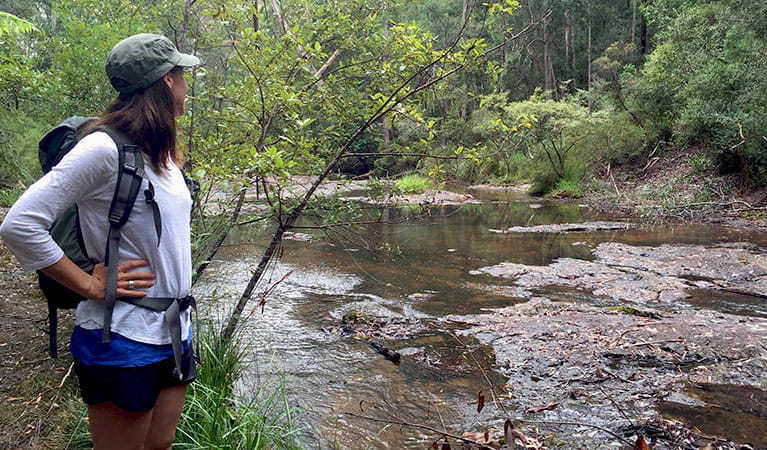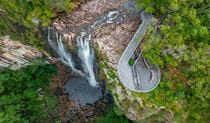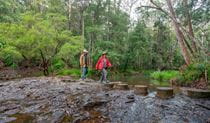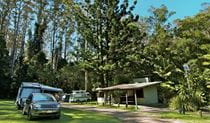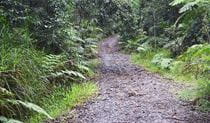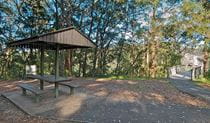Boggy Creek walk
North Coast
Overview
Boggy Creek walk in Whian Whian State Conservation Area takes you through blackbutt forest and along the beautiful Boggy Creek to Minyon Falls. You can swim in the inviting pools along the creek.
- Distance
- 4km return
- Time suggested
- 1 - 2hrs
- Grade
- Grade 3
- Please note
Take sunscreen and insect repellent before you set out, and remember to bring a hat and drinking water
Boggy Creek walk is an easy, short walk that allows you to meander through the rainforest at your leisure between Minyon falls and Rummery Park campground in Whian Whian State Conservation Area.
The walk is a great one for the kids and is popular throughout the seasons. In the cooler months, it’s much quieter and you might even find you have the area all to yourself.
Along the way, you can relax by swimming in the many pools near the creek side section of the walk. This area is lovely; large turpentine trees, water gums and brushbox line the creek, as well as blackbutts and flooded gum.
Stop for lunch at Rummery Park campground or head back and take in the breathtaking views at Minyon Falls lookout, where Repentance Creek plunges over 100m, flowing down over enormous cliffs that were once part of the Tweek Volcano. If you still feel like walking, Minyon Falls walking track starts from Minyon Falls.
Nearby:
Map

Map legend

Local alerts
For the latest updates on fires, closures and other alerts in this area, see https://www.nationalparks.nsw.gov.au/things-to-do/walking-tracks/boggy-creek-walk/local-alerts
General enquiries
- National Parks Contact Centre
- 7am to 7pm daily
- 1300 072 757 (13000 PARKS) for the cost of a local call within Australia excluding mobiles
- parks.info@environment.nsw.gov.au
Park info
- in Whian Whian State Conservation Area in the North Coast region
Whian Whian State Conservation Area is always open but may have to close at times due to poor weather.
- in Nightcap National Park in the North Coast region
Nightcap National Park is always open but may have to close at times due to poor weather, fire danger or management operations.
Visitor info
All the practical information you need to know about Boggy Creek walk.
Maps and downloads
Learn more
Boggy Creek walk is in Whian Whian State Conservation Area. Here are just some of the reasons why this park is special:
4,000 years of Aboriginal culture

The conservation area is located within the traditional lands of the Widjabal clan of the Bundjalung Nation. Evidence from recorded sites suggests Aboriginal use of the Nightcap Range for at least the last 4,000 years. The area has intrinsic cultural values to the Widjabal People and the land has significant connections with other recorded sites in the adjacent Nightcap National Park.
- Byan Yangala loop walk Travel back in time as you walk through ancient Gondwana rainforest on the Byan Yangala loop walk. Immerse yourself in nature less than 1 hour from Byron Bay.
Historic heritage of timber-getters

Lured by the opportunity of employment in difficult times, timber-getters began logging in the Whian Whian area in the 1830s for red cedar, a particularly sought after timber. In 1871, surveyors identified a track over Nightcap Range to link Lismore with Murwillumbah. This allowed cedar-getters access to previously isolated expanses of forest. The Rummery Park campground was originally a forestry camp, and its use dates back to the 1930s. The inter-war period was the most active period for forestry use of the campground. Peates Mountain Road (now part of the Nightcap track) was built during the depression of the 1920s and 1930s. Sleeper-cutters who claimed timber unsuitable for milling, camped nearby on the other side of Boggy Creek at Rummery Park.
- Historic Nightcap walking track Historic Nightcap walking track leads through World Heritage-listed rainforest, offering scenic views across Nightcap National Park and Whian Whian State Conservation Area, near Byron Bay.
Plant life galore

An astounding 520 plant species have been recorded here – making it an incredibly diverse place when it comes to vegetation. There are 10 broad ecosystems, including subtropical and warm temperate rainforests and various types of wet sclerophyll forest.
- Boggy Creek walk Boggy Creek walk in Whian Whian State Conservation Area takes you through blackbutt forest and along the beautiful Boggy Creek to Minyon Falls. You can swim in the inviting pools along the creek.
- Historic Nightcap walking track Historic Nightcap walking track leads through World Heritage-listed rainforest, offering scenic views across Nightcap National Park and Whian Whian State Conservation Area, near Byron Bay.
Walk with the animals

There’s also an incredible variety of native animal species thriving in these rainforests – over 270 native species, around 50 of which are listed as threatened, including the spotted tailed quoll. Koalas and Albert’s lyrebird, with its distinctive calls and mimicking echoes, can often be heard through the forest in the cooler months.
- Byan Yangala loop walk Travel back in time as you walk through ancient Gondwana rainforest on the Byan Yangala loop walk. Immerse yourself in nature less than 1 hour from Byron Bay.
- Whian Whian mountain biking trails Suitable for bushwalkers, cyclists and horseriders, Whian Whian mountain biking trails near Byron Bay offer stunning views of waterfalls and rainforest.
World heritage worthy

The conservation area has similar vegetation and natural heritage values as those found in the adjoining Nightcap National Park, one of the 50 reserves in northeast NSW and southeast Queensland that make up World Heritage Central Eastern Rainforest Reserves Australia.
- Whian Whian mountain biking trails Suitable for bushwalkers, cyclists and horseriders, Whian Whian mountain biking trails near Byron Bay offer stunning views of waterfalls and rainforest.
Plants and animals protected in this park
Animals
-

Albert's lyrebird (Menura alberti)
The Albert’s lyrebird is much rarer than the superb lyrebird. Distinguished by its richer brown plumage and less elaborate tail feathers, it’s protected as a threatened species in NSW.
-

Koala (Phascolarctos cinereus)
One of the most renowned Australian animals, the tree-dwelling marsupial koala can be found in gum tree forests and woodlands across eastern NSW, Victoria and Queensland, as well as in isolated regions in South Australia. With a vice-like grip, this perhaps most iconic but endangered Australian animal lives in tall eucalypts within a home range of several hectares.
-

Common brushtail possum (Trichosurus vulpecula)
One of the most widespread of Australian tree-dwelling marsupials, the common brushtail possum is found across most of NSW in woodlands, rainforests and urban areas. With strong claws, a prehensile tail and opposable digits, these native Australian animals are well-adapted for life amongst the trees.
-

Kookaburra (Dacelo novaeguineae)
Of the 2 species of kookaburra found in Australia, the laughing kookaburra is the best-known and the largest of the native kingfishers. With its distinctive riotous call, the laughing kookaburra is commonly heard in open woodlands and forests throughout NSW national parks, making these ideal spots for bird watching.

